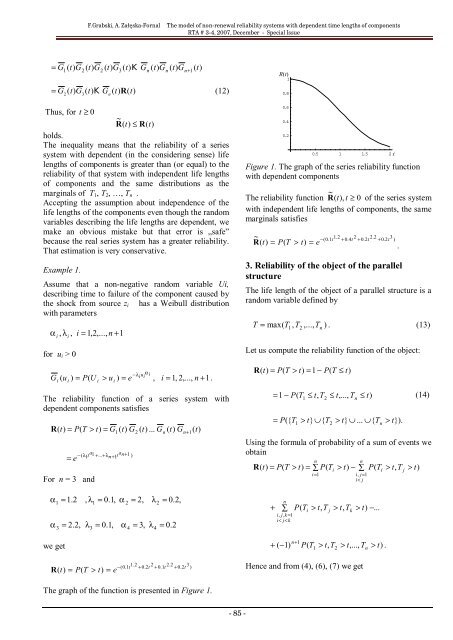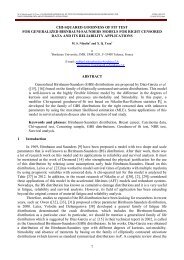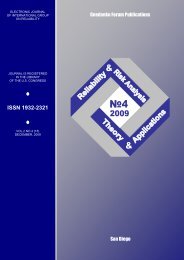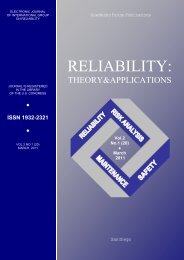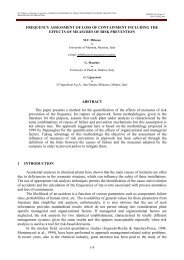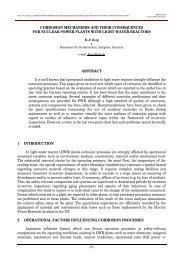F.Grabski, A. Zaska-FornalThe model of non-renewal reliability systems with dependent time lengths of componentsRTA # 3-4, 2007, December - Special IssueR(t1, t2,..., tn) = P(T1> t , T12> t ,..., T2n> tn)R ( t , tijij) = P(Ti> t , Tij> tj)= P(m<strong>in</strong>(U..., m<strong>in</strong>(= P(U..., Un= P(U... P(UThusR(tn11, U, U> max( t1, tn2Un111n + 1> t , U22n−1> t ) P(U> max( t,..., tG (max( twhereG ( ui<strong>in</strong>n−1, t) = P(Ui = 1, 2,..., n + 1.) > t) > t> max( t, t2nn−1) G1), U> max( t, t, m<strong>in</strong>( Un) = G ( t<strong>in</strong>1> un1)n+1i1, tn + 121, t)) P(U) G( tn2)2),> t, U2n)))n + 1(max( t) = 1−G ( uii3) > t> t ) .1n, t22,)) ...) = P(T ≤ ui),(4)The reliability functions of the components can beobta<strong>in</strong>ed as marg<strong>in</strong>al distributions comput<strong>in</strong>g the limitof the function (4), when++++t1→ 0 ,..., ti−1→ 0 , ti+1→ 0 ,..., tn→ 0 .= G ( t ) Giii + 1 =j,i+1(max( t , tit could be proved thatP(T1= P(T> t | T111ii+1)) Gi,j = 1,2,..., n −1,2> t | Tand generallyP(T > ti1= P(T > ti| Ti| T> t ,..., T2i+1i+12> t> t2)i+1> tn,..., Ti+1> tnni+2)> tn)( ti+1),), i = 1,2,..., n −1.(7)(8)(9)That property asserts that the life length of e i dependsonly on the life length of the next component e i+1 , doesnot depend on the life lengths of the rest of thecomponents. That is a certa<strong>in</strong> k<strong>in</strong>d of Markov property.2. Reliability of the object with the seriesstructureIf the object has a series reliability structure then itslife length T is the random variable def<strong>in</strong>ed by theformulaT = m<strong>in</strong>(T1 , T2,..., Tn) . (10)Us<strong>in</strong>g (4) we can determ<strong>in</strong>e the reliability function:R ( t ) = P(T > t ) = G ( t ) G+ 1(t ), i 1,2,..., n.(5)i i i i i i i i=R(t)= P(T > t)= P(T1> t,T2> t,...,Tn> t)The bivariate reliability functions can be determ<strong>in</strong>edby comput<strong>in</strong>g the limit of (4), when= R(t,t,...,t)(11)tt1→ 0j+1+→ 0R ( t , tiji + 1 t , Tt) Gi+1> tj,i,j = 1,2,..., n − 1,jijj→ 0j)j+1( tj+),,..., tj−1→ 0+,(6)= G ( t)G12( t)... Gn( t)Gn+1( t).Let us compare the function with the reliabilityfunction of a series system <strong>in</strong> which the life lengths ofthe components T 1 , T 2 , …,T n are <strong>in</strong>dependent andtheir reliability functions are def<strong>in</strong>ed by (5). Let~R ( t),t ≥ 0 be a reliability function of that system. ItsatisfiesR ~( t)= P(T > t)= P(T > t,T2> t,K , Tn >)1t)= R1 ( t)R2( t)KRn( t- 84 -
F.Grabski, A. Zaska-FornalThe model of non-renewal reliability systems with dependent time lengths of componentsRTA # 3-4, 2007, December - Special Issue= G1 ( t)G2( t)G2( t)G3(t)KGn ( t)Gn( t)Gn+1(t)= G t)G ( t)KGn ( t)R()(12)2( 3tThus, for t ≥ 0~R(t)≤ R(t)holds.The <strong>in</strong>equality means that the reliability of a seriessystem with dependent (<strong>in</strong> the consider<strong>in</strong>g sense) lifelengths of components is greater than (or equal) to thereliability of that system with <strong>in</strong>dependent life lengthsof components and the same distributions as themarg<strong>in</strong>als of T 1 , T 2 , …, T n .Accept<strong>in</strong>g the assumption about <strong>in</strong>dependence of thelife lengths of the components even though the randomvariables describ<strong>in</strong>g the life lengths are dependent, wemake an obvious mistake but that error is „safe”because the real series system has a greater reliability.That estimation is very conservative.Example 1.Assume that a non-negative random variable Ui,describ<strong>in</strong>g time to failure of the component caused bythe shock from source z i has a Weibull distributionwith parametersα i, λ i, i = 1,2,..., n + 1for u i > 0−λG ( u ) = P(U > u ) = ei u i, i = 1, 2,..., n + 1.iiiiThe reliability function of a series system withdependent components satisfiesR(t)= P(T > t)= G= eFor n = 3 andG−(λ1ta1+ ... + λn+1t a n+1 )ttαiGG1( )2( ) ...n( )n+1()ttR(t)10.80.60.40.20.5 1 1.5 2 tFigure 1. The graph of the series reliability functionwith dependent components~The reliability function R ( t),t ≥ 0 of the series systemwith <strong>in</strong>dependent life lengths of components, the samemarg<strong>in</strong>als satisfies~ −(0.1t1.2+ 0.4t2+ 0.2t2.2+ 0.2 t 3)R(t)= P(T> t)= e3. Reliability of the object of the parallelstructureThe life length of the object of a parallel structure is arandom variable def<strong>in</strong>ed byT = max(T1 , T2,..., Tn) . (13)Let us compute the reliability function of the object:R(t)= P(T > t)= 1 − P(T ≤ t)= 1 − P(T= P({T11≤ t,T2> t}∪{T≤ t,...,T2n≤ t)> t}∪ ... ∪{Tn.> t}).(14)Us<strong>in</strong>g the formula of probability of a sum of events weobta<strong>in</strong>R(t)= P(T > t)= ∑ P(Tni=1<strong>in</strong>> t)− ∑ P(T > t,T > t)i,j=1i t)−...we get+ ( −1)n+1P(T1> t,T2> t,...,Tn> t) .R(t)= P(T> t)= e−(0.1t1.2+ 0.2t2+ 0.1t2.2+ 0.2t3)Hence and from (4), (6), (7) we getThe graph of the function is presented <strong>in</strong> Figure 1.- 85 -
- Page 1 and 2:
ISSN 1932-2321RELIABILITY:Theory &
- Page 5 and 6:
e‐journal “Reliability: Theory&
- Page 7:
e‐journal “Reliability: Theory&
- Page 10 and 11:
A.Blokus-Roszkowska Analysis of com
- Page 12:
A.Blokus-Roszkowska Analysis of com
- Page 20 and 21:
R. Bri Stochastic ageing models - e
- Page 22 and 23:
R. Bri Stochastic ageing models - e
- Page 24 and 25:
R. Bri Stochastic ageing models - e
- Page 26 and 27:
R. Bri Stochastic ageing models - e
- Page 28 and 29:
T.BudnyTwo various approaches to VT
- Page 30 and 31:
T.BudnyTwo various approaches to VT
- Page 32 and 33:
T.BudnyTwo various approaches to VT
- Page 34 and 35: J.Duarte, C.Soares Optimisation of
- Page 36 and 37: J.Duarte, C.Soares Optimisation of
- Page 38 and 39: J.Duarte, C.Soares Optimisation of
- Page 40 and 41: J.Soszyska, P.Dziula, M.Jurdziski,
- Page 42 and 43: J.Soszyska, P.Dziula, M.Jurdziski,
- Page 44 and 45: J.Soszyska, P.Dziula, M.Jurdziski,
- Page 46 and 47: J.Soszyska, P.Dziula, M.Jurdziski,
- Page 48 and 49: J.Soszyska, P.Dziula, M.Jurdziski,
- Page 50 and 51: J.Soszyska, P.Dziula, M.Jurdziski,
- Page 52 and 53: J.Soszyska, P.Dziula, M.Jurdziski,
- Page 54 and 55: M.Elleuch, B.Ben, F.MasmoudiImprove
- Page 56 and 57: M.Elleuch, B.Ben, F.MasmoudiImprove
- Page 58 and 59: M.Elleuch, B.Ben, F.MasmoudiImprove
- Page 60 and 61: F.GrabskiApplications of semi-Marko
- Page 62 and 63: F.GrabskiApplications of semi-Marko
- Page 64 and 65: F.GrabskiApplications of semi-Marko
- Page 66 and 67: F.GrabskiApplications of semi-Marko
- Page 68 and 69: F.GrabskiApplications of semi-Marko
- Page 70 and 71: F.GrabskiApplications of semi-Marko
- Page 72 and 73: F.GrabskiApplications of semi-Marko
- Page 74 and 75: F.GrabskiApplications of semi-Marko
- Page 76 and 77: F.Grabski The random failure rate -
- Page 78 and 79: F.Grabski The random failure rate -
- Page 80 and 81: F.Grabski The random failure rate -
- Page 82 and 83: F.Grabski The random failure rate -
- Page 86 and 87: F.Grabski, A. Zaska-FornalThe model
- Page 88 and 89: F.Grabski, A. Zaska-FornalThe model
- Page 90 and 91: R.GuoAn univariate DEMR modelling o
- Page 92 and 93: R.GuoAn univariate DEMR modelling o
- Page 94 and 95: R.GuoAn univariate DEMR modelling o
- Page 96 and 97: R.GuoAn univariate DEMR modelling o
- Page 98 and 99: S.Guze Numerical approach to reliab
- Page 100 and 101: S.Guze Numerical approach to reliab
- Page 102 and 103: S.Guze Numerical approach to reliab
- Page 104 and 105: S.Guze, K.Koowrocki Reliability ana
- Page 106 and 107: S.Guze, K.Koowrocki Reliability ana
- Page 108 and 109: S.Guze, K.Koowrocki Reliability ana
- Page 110 and 111: S.Guze, K.Koowrocki Reliability ana
- Page 112 and 113: L.Knopik Some remarks on mean time
- Page 114 and 115: L.Knopik Some remarks on mean time
- Page 116 and 117: K.Koowrocki Reliability modelling o
- Page 118 and 119: K.Koowrocki Reliability modelling o
- Page 120 and 121: K.Koowrocki Reliability modelling o
- Page 122 and 123: K.Koowrocki Reliability modelling o
- Page 124 and 125: K.Koowrocki Reliability modelling o
- Page 126 and 127: K.Koowrocki Reliability modelling o
- Page 128 and 129: K.Koowrocki Reliability modelling o
- Page 130 and 131: K.Koowrocki Reliability modelling o
- Page 132 and 133: K.Koowrocki Reliability modelling o
- Page 134 and 135:
K.Koowrocki Reliability modelling o
- Page 136 and 137:
K.Koowrocki Reliability modelling o
- Page 138 and 139:
K.Koowrocki Reliability modelling o
- Page 140 and 141:
A. Kudzys Transformed conditional p
- Page 142 and 143:
A. Kudzys Transformed conditional p
- Page 144 and 145:
A. Kudzys Transformed conditional p
- Page 146 and 147:
A. Kudzys Transformed conditional p
- Page 148 and 149:
B. Kwiatuszewska-Sarnecka On asympt
- Page 150 and 151:
B. Kwiatuszewska-Sarnecka On asympt
- Page 152 and 153:
B. Kwiatuszewska-Sarnecka On asympt
- Page 154 and 155:
B. Kwiatuszewska-Sarnecka On asympt
- Page 156 and 157:
B. Kwiatuszewska-Sarnecka On asympt
- Page 158 and 159:
B. Kwiatuszewska-Sarnecka On asympt
- Page 160 and 161:
B. Kwiatuszewska-Sarnecka On asympt
- Page 162 and 163:
B. Kwiatuszewska-Sarnecka On asympt
- Page 164 and 165:
B. Kwiatuszewska-Sarnecka On asympt
- Page 166 and 167:
B. Kwiatuszewska-Sarnecka On asympt
- Page 168 and 169:
B. Kwiatuszewska-Sarnecka On asympt
- Page 170 and 171:
B. Kwiatuszewska-Sarnecka On asympt
- Page 172 and 173:
U. Rakowsky Fundamentals of the Dem
- Page 174 and 175:
U. Rakowsky Fundamentals of the Dem
- Page 176 and 177:
U. Rakowsky Fundamentals of the Dem
- Page 178 and 179:
U. Rakowsky Fundamentals of the Dem
- Page 180 and 181:
U. Rakowsky Fundamentals of the Dem
- Page 182 and 183:
U. Rakowsky Fundamentals of the Dem
- Page 184 and 185:
J. Soszyska Systems reliability ana
- Page 186 and 187:
J. Soszyska Systems reliability ana
- Page 188 and 189:
J. Soszyska Systems reliability ana
- Page 190 and 191:
J. Soszyska Systems reliability ana
- Page 192 and 193:
J. Soszyska Systems reliability ana
- Page 194 and 195:
J. Soszyska Systems reliability ana
- Page 196 and 197:
D. Vali Reliability of complex syst
- Page 198 and 199:
D. Vali Reliability of complex syst
- Page 200 and 201:
D. Vali Reliability of complex syst
- Page 202 and 203:
D. Vali Reliability of complex syst
- Page 204 and 205:
E. Zio Soft computing methods appli
- Page 206 and 207:
E. Zio Soft computing methods appli
- Page 208 and 209:
E. Zio Soft computing methods appli
- Page 210 and 211:
E. Zio Soft computing methods appli
- Page 212 and 213:
E. Zio Soft computing methods appli
- Page 214 and 215:
E. Zio Soft computing methods appli
- Page 216 and 217:
E. Zio Soft computing methods appli
- Page 218 and 219:
E. Zio Soft computing methods appli
- Page 220 and 221:
E.Zio, P.Baraldi, I.Popescu Optimiz
- Page 222 and 223:
E.Zio, P.Baraldi, I.Popescu Optimiz
- Page 224 and 225:
E.Zio, P.Baraldi, I.Popescu Optimiz
- Page 226 and 227:
E.Zio, P.Baraldi, I.Popescu Optimiz
- Page 228 and 229:
E.Zio, P.Baraldi, I.Popescu Optimiz
- Page 230 and 231:
NOTES


